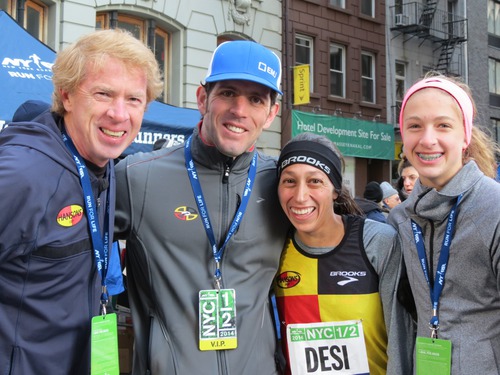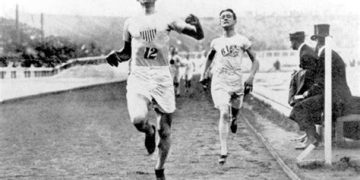DESIREE LINDEN “ALL-IN” FOR BOSTON MARATHON
By David Monti, @d9monti
(c) 2014 Race Results Weekly, all rights reserved
BOSTON (20-Apr) — At the 2011 Boston Marathon, Desiree Linden nearly made history. The petite but feisty athlete, who ran that year under her maiden name Davila, came within two seconds of breaking a 26-year victory drought for American athletes here. Trading surges with Kenya’s Caroline Kilel in the final 800 meters on Boylston Street, she would finish second in 2:22:38, the fastest time ever by an American at the Boston Marathon.
“It was like the perfect race for me,” Linden told reporters at the time. “I couldn’t ask for anything more.”
But deep inside, Linden was disappointed. How could she come so close to winning Boston and let it slip away?
“I think that’s why I was so conflicted afterwards,” Linden revealed in a press conference here yesterday. “It was a great moment and you’re real proud of it, but you’re looking forward to the next big thing. I think when I crossed the line I was standing with Rob Friedman (an executive from race sponsor John Hancock Financial). He was like, great job; this is awesome! But I was like, I can’t wait to go back.”
Linden, 30, who lives in Washington, Mich., and runs for the Hansons Brooks Original Distance Project, is finally back here again after a tumultuous three years. After her runner-up finish at Boston, she took the same spot at the USA Olympic Marathon Trials in Houston, Texas, nine moths later, qualifying her for her first Olympic team. But that euphoria turned to dismay when an insidious hip injury hobbled the former Arizona State athlete, forcing her to curtail her training and drop out of the London Olympic Marathon before the 5 km mark.
Since then, Linden has been rebuilding. She ran her first competitive race since the Olympics last June at the Oakley New York Mini 10-K, clocking a pain-free 33:22. She followed up with a second place at the USA Half-Marathon Championships in Duluth later that June (1:11:26), then ran a solid 2:29:15 at the BMW Berlin Marathon last September, good for fifth place. But that’s not like being in Boston, she said.
“I mean, it’s Boston,” she intoned. “THE Marathon. Where it all started. It’s such a rich history no matter what place you’re in.”
To prepare for this year’s race, Linden decided to do her first-ever high altitude training stint, going to the High Altitude Training Center in Iten, Kenya, the famed facility owned and managed by former world champion Lornah Kiplagat and her husband Pieter Langerhorst. From January 7th to February 16th, she logged long weeks of training on Kenya’s red clay roads, building her base for Boston.
“We just basically lengthened the base before we started the marathon-specific stuff,” said Kevin Hanson who, with twin brother Keith, have coached Linden for the last eight years. “When she was in Kenya, she worked at getting her base and her mileage up, but she didn’t really do a whole lot of intensity stuff there.”
The Kenya trip, where she roomed with Canadian marathon record-holder Lanni Marchant, was also about rejuvenating Linden’s spirit after such a difficult 2012 and 2013. She needed a change of scenery, but also needed to feel that she was “all-in” for Boston.
“I really needed to find a way to enjoy it again, and the opportunity presented itself to go somewhere new, train with new people, and be in a different environment,” Linden explained. She added: “I was passionate again. Obviously, I’m very passionate about running Boston.”
Her coaches explained that success at Boston is much more about training for the race’s specific challenges than it is for the marathon distance itself. Although the Boston course has a net elevation drop of 136 meters –more than three times the allowable limit for record-setting– it is nonetheless a difficult run. That’s because the course’s highest elevation point is the start, and it goes merrily downhill for nearly 26 kilometers, before confronting runners with two serious climbs: one at 29 km and the other –the world famous Heart Break Hill– which peaks at about 33 km. After that, it can be difficult to take advantage of the downhill to the finish because many athletes have already trashed their legs on the climbs.
“You don’t train for the distance,” said Kevin Hanson. “You train for the course. Negative splits (running faster in the second half) are so important on this course.” He added: “She knows this course better than anybody in the field. She knows each turn.”
Linden, who enjoys fine whiskey when she’s not training, has high standards. Being the top American here would be
an excellent achievement –she would need to beat Olympic medalist Shalane Flanagan– but Linden wants to win the entire race. For her, it’s personal.
“It’s something I want for myself,” she said. “People are proud no matter what you do.”
Author

Larry Eder has had a 52-year involvement in the sport of athletics. Larry has experienced the sport as an athlete, coach, magazine publisher, and now, journalist and blogger. His first article, on Don Bowden, America's first sub-4 minute miler, was published in RW in 1983. Larry has published several magazines on athletics, from American Athletics to the U.S. version of Spikes magazine. He currently manages the content and marketing development of the RunningNetwork, The Shoe Addicts, and RunBlogRun. Of RunBlogRun, his daily pilgrimage with the sport, Larry says: "I have to admit, I love traveling to far away meets, writing about the sport I love, and the athletes I respect, for my readers at runblogrun.com, the most of anything I have ever done, except, maybe running itself." Also does some updates for BBC Sports at key events, which he truly enjoys. Theme song: Greg Allman, " I'm no Angel."
View all posts





















